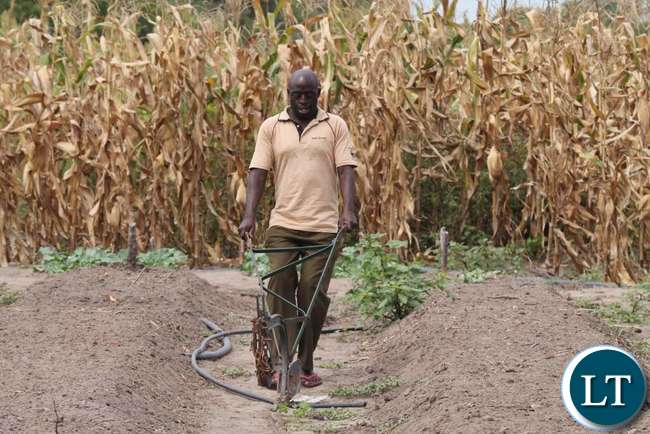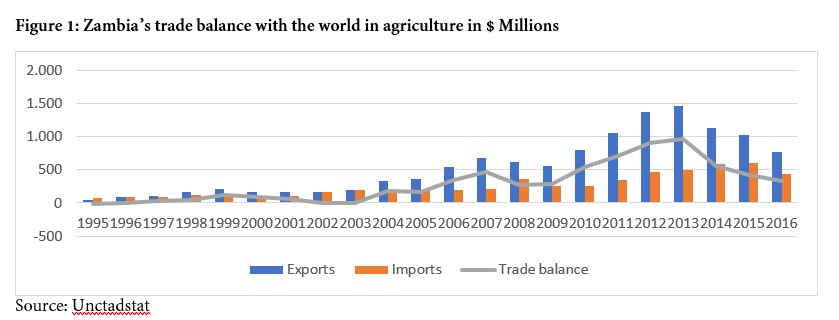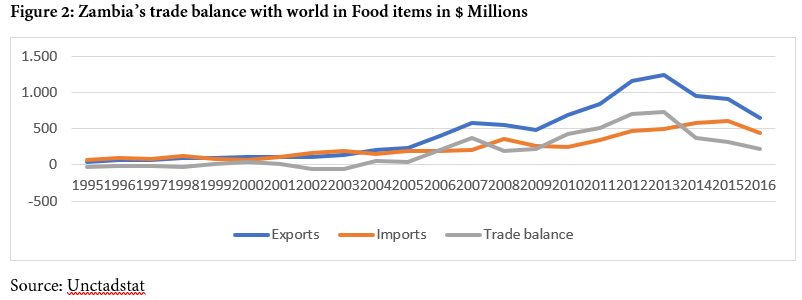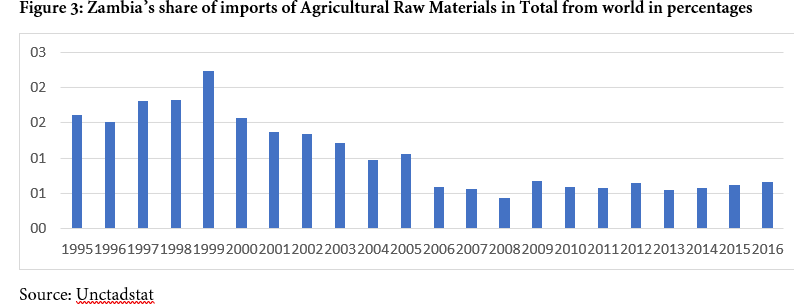
By economic.governance
Zambia’s agriculture has a special place in the country’s political and economic agenda. Since independence, everyone has been saying it is important but they don’t show figures to back their statements. But, as we celebrate our independence, let us look at only a few of the issues to see whether, in fact we are independent in this sector. First, the argument for agriculture; second, international trade in agriculture; third, Is Zambia competitive in Africa’s Agriculture value added in the Economy? And forth, way forward.
First, why is Zambia clinging to the sector that others are ceding for manufacturing?
Why is Zambia clinging to the sector that others are ceding for manufacturing where the value for money and job creation is? For over five decades, we have argued that agriculture is an important sector, stating that its contribution to total labour force in share terms is about 70-80%. Even when that share declined to 60 per cent and has remained flat for over three decades, we continue to use the 70 per cent argument. Table 1 below shows that though slowly, the share has been eroding and may plummet further in the next ten years. More importantly, we also know that a large chunk of that share is not something that we should really be boasting about because it is subsistence or rudimentary. Further, the so-called importance of the sector is largely perceived in local context. As Table shows, some countries including African ones are moving away from agriculture as a main source of employment. These are the countries such as Mauritius and Tunisia in Africa that are experiencing growth in manufacturing as a major source of job creation and poverty reduction. In Asia, it is manufacturing, hardly agriculture that powered countries to achieve millennium development goals while Africa was slumbering and, history may repeat itself in the same way for Agenda 2030. Even if agriculture employs more people than any other sector, the point is that most of these employees are engaged in subsistence activities.
Table 1: Share of Zambia’s agriculture in Total Labour Force in percentages
| 1980 | 2016 | |
|---|---|---|
| Bangladesh | 69 | 38 |
| Mauritius | 28 | 6 |
| Thailand | 72 | 41 |
| Tunisia | 36 | 20 |
| Viet Nam | 76 | 56 |
| Zambia | 72 | 59 |
Source: Unctadstat
The trade figures do not support the agriculture argument
The English dictionary explains the word subsistence as, ‘denoting or relating to production at a level sufficient only for one’s own use or consumption, without any surplus for trade.’ The definition is backed by statistics that show that Zambia’s participation in international trade in agriculture is stunted and almost not there. In the context of international and even regional trade, Zambia is very far from integration in this sector and is simply not competitive. Despite the good news that the country’s trade balance in agriculture with the world is positive and growing (Figure 1), exports and imports of agriculture are not only too low but are hardly growing significantly. Exports and imports totalled only $ 761 and $ 480 million respectively in 2016, a drop from $ 1.5 billion for exports in 2013. So, exports in blue line in absolute terms are declining as the trend in the graph shows.
The good news is that unlike most African countries, Zambia seems to have a strong resolve not to be a perpetual net-food importer. As can be seen from Figure 2, the country is exporting more food than it is importing. But, again, the figures in absolute terms of only exports of $600 million and imports of $400million giving a trade surplus of $200million is simply too low to propel any development.
Agriculture export products are inferior and too low in value
Exports of tobacco, maize, cotton and others listed in Table 2 are not dynamic products. Even if they were useful, their absolute values are simply too low. Honorable Minister, look at Table 2 below and tell the Zambians, how can we be exporting $ tobacco worth less than $200 million to the world? In June this year, the Minister of Agriculture boasted, “We are the biggest producer of non genetic maize in the region. Our total consumption of maize as a country is 1.8million metric tonnes. Last year we produced 2.8million metric tonnes. This year we have unprecedented production of 3.8 million”, Said Hon Siliya. Yet exports to the world are less than $200 million. These are not competitive trade figures. We cannot even grow enough vegetables to export, at least to African countries, instead we export less than $20million. The Zambian Ambassador in South Africa was pictured with South African farmers. How much investment have they made in the country to support trade in agriculture?
Table 2: Zambia’s exported agriculture products to world in $ Millions
| 2016 | |
|---|---|
| [TOTAL] Total all products | 5,801 |
| [121] Tobacco, unmanufactured; tobacco refuse | 160 |
| [044] Maize (not including sweet corn), unmilled | 117 |
| [061] Sugar, molasses and honey | 112 |
| [263] Cotton | 65 |
| [081] Feeding stuff for animals (no unmilled cereals) | 48 |
| [223] Oil seeds & oleaginous fruits (incl. flour, n.e.s.) | 22 |
| [122] Tobacco, manufactured | 20 |
| [054] Vegetables | 16 |
| [046] Meal and flour of wheat and flour of meslin | 13 |
| [431] Animal or veg. oils & fats, processed, n.e.s.; mixt. | 13 |
Source: Unctadstat
Why are we not importing more Agricultural Raw Materials as inputs for expansion of productivity?
I m not expert in agriculture but, I thought imports of agricultural raw materials signals an insatiable appetite for expansion of production in agriculture since it must be seen as an input. As I understand, there are three main groupings, first, “basic natural resources that are input into the agricultural process to produce various types of food, and finally, fertilizers, pesticides, or other organic means of controlling damaging insect populations, as well as mechanized equipment and reliable sources of energy to run modern farming operations.” Yet, as Figure 3 shows, the share of imports of these items account for very little in total imports of $7 billion and this is even eroding. To put this in practical terms, imports amounted to only $ 46 million in 2016. What can this amount do to expand productivity? Or how much is being imported as capital and inputs in the expansion of production in agriculture?
Third, Is Zambia competitive in Africa’s Agriculture value added in the Economy?
Despite the many political statements made publicly that Zambia will be the hub of agriculture in the region, the country is not competitive regionally. In 1970, Zambia ranked number 29 among African countries in agriculture value added in the economy, meaning, countries even with smaller GDP like Malawi and Niger have more agriculture in their economies than Zambia as Table 3 (a) below shows. In 2016, the country ranked number 27, not far from the ranking of about five decades. Today, Zambia’s agriculture value added in the economy is only $ 1.6billion compared to $2.6 billion for Niger or $6.7 billion for Cote D’Ivoire. It means, the country has not been making progress in regional competitive terms. In terms of share in the GDP, agriculture value added declined from a once-upon a time high mark of 33% in 1993 to now 8%. It also means that achieving the objectives set in agriculture of reducing poverty, creating jobs and structural transformation will remain more in public statements than in action.
Table 3: Zambia’s Agriculture value added in Economy in $ Millions compared with African countries
| Table (a) 1970 | Table (b) 2015 | |||
|---|---|---|---|---|
| In $Millions | In $Millions | |||
| Africa | 22,907 | Africa | 347,741 | |
| 1 | Nigeria | 5,598 | Nigeria | 102,042 |
| 2 | Egypt | 2,058 | Egypt | 35,750 |
| 3 | Ghana | 1,354 | Sudan | 25,785 |
| 4 | Ethiopia (…1991) | 1,335 | Ethiopia | 22,679 |
| 5 | South Africa | 1,230 | Algeria | 19,231 |
| 6 | Mozambique | 1,194 | Kenya | 19,017 |
| 7 | Morocco | 862 | Tanzania | 13,528 |
| 8 | DRC | 808 | Morocco | 12,516 |
| 9 | Kenya | 802 | Angola | 8,131 |
| 10 | Algeria | 684 | DRC | 6,945 |
| 11 | Uganda | 616 | Côte d’Ivoire | 6,774 |
| 12 | Angola | 541 | Ghana | 6,752 |
| 13 | Sudan (…2011) | 479 | South Africa | 6,667 |
| 14 | Malawi | 470 | Uganda | 5,959 |
| 15 | Tanzania | 412 | Cameroon | 5,957 |
| 16 | Côte d’Ivoire | 408 | Mali | 4,806 |
| 17 | Cameroon | 292 | Tunisia | 4,168 |
| 18 | Mali | 273 | Burkina Faso | 3,437 |
| 19 | Zimbabwe | 271 | Mozambique | 3,403 |
| 20 | Madagascar | 266 | Rwanda | 2,646 |
| 21 | Tunisia | 229 | Niger | 2,601 |
| 22 | Niger | 210 | Chad | 2,495 |
| 23 | Senegal | 195 | Madagascar | 2,289 |
| 24 | Burkina Faso | 182 | Sierra Leone | 2,247 |
| 25 | Somalia | 180 | Senegal | 1,857 |
| 26 | Mauritania | 158 | Benin | 1,737 |
| 27 | Burundi | 155 | Zambia | 1,662 |
| 28 | Guinea | 150 | ||
| 29 | Zambia | 139 |
And forth, what next?
What next is a unique question because even I have no special answers. No one has, otherwise we would be better today. But in trying to search for answers, there are some obviously little things that need addressing. We have Israel as Zambia’s development partner. Yes, our Head of State was there not long ago. One of that country’s strengths lies in the specialization in irrigation which is essential for agriculture. Expanding irrigation infrastructure and coverage and investing more money from cash obtained from copper sales, in agriculture is key. Productivity, seen in the growth in agriculture value added is one thing, but this is too low.
The budget for agriculture development needs to be expanded but with the strict objective of manufactured products. No more should we talk about agriculture but manufactured goods of an agriculture nature. History shows that budget for agriculture has been minimal. Table 4 shows the shares of agriculture from 2009-2014 in total national budget as announced by the Minister of Finance for 2008-2013 address. Clearly, the shares have been eroding instead of increasing and perhaps this trend continues today. There is need for stronger infrastructure and manufacturing value added in the economy. Growth does not come with little thinking. It comes with big thinking. Stop making big statements on little steps of achievement.
Table 4: Budget for agriculture as a share of total budget in percentages
| 2009 | 2010 | 2011 | 2012 | 2013 | 2014 |
|---|---|---|---|---|---|
| 7.2 | 6.8 | 6 | 6.1 | 5.8 | 4.1 |
Source: Minister of Finance budget address 2013





Good read @ economic governance… First off, in my humble opinion we need to look at political policy and traction to get will power going. As we know it, agriculture is a power house of any economy even though some economies have made a slight shift away from agriculture. Zambia is rightfully clinging to the sector because agriculture has backwards and forwards linkages to the entire fabric of an economy, capable of pulling all industries positively forward. What seem done inappropriately is throwing money at the problem. (… cont)
(—Cont) I mean, we saw when the Zambian government initiated credit programs that were undertaken by players in the agriculture sector, according to Chonya’s citation of (Mwanamambo, Salin & Mukumbuta, 2007). Mwanamambo et, al (2007), who observed that since the early 1960s when this initiative was implemented, despite initial varying levels of success, eventual failure was almost certain.
(— cont) Additional literature informs that in more attempt to develop the agriculture sector, in 1996, the Zambian government participated in the Agricultural Sector Investment Program (ASIP) headed by the World Bank and first implemented as a trial program that included coffee and cotton among the priorities and objectives of ASIP (The World Bank 2002, Mwanaumo 1999, OECD 2003). Participation in the ASIP program was pursued with the objective of promoting public institutions as agents for agriculture finance and technical assistance in the fields of agricultural research, training and development of rural institutions.
(—cont) This was a sector-wise program geared on utilising scarce resources to attain agriculture development. According to the World Bank, the aim of the program was to develop a general government and/or donor investment program by integrating investment projects, sharing technical knowledge and expertise, training and policy implementation (World Bank, 2002). The broad objectives of the ASIP generally ended up in failure as agriculture productivity continued on its long-term decline (World Bank 2002; p.5).
We have had failure after failure and major money misplaced in an attempt to revive the agriculture system. Agriculture finance and policy has consistently been arrived at by researchers and industrial literature to be a bottleneck. The World bank (2015)… observes that it is not that banks have insufficient funds to fund the sector but unwillingness of the banks to do so. (—cont)
(— cont) reason of this unwillingness according to my humble opinion is policy and will that could help reduce the information gap that would unlock agriculture finance through Agricultural Innovation Systems (AIS). AIS would play a major part to influence financial intermediaries in that issues such as information asymmetries, credit risk management and transformation, including monitoring and control of loans is easily done by banks, therefore, unlocking the funds needed in the sector which is challenge at the moment. Overlooking this will be a repeat of passed attempts that have been a failure thus far. (END)
@economic.governance you are trying to run before you can walk. To quote the late great Ali Mazrui “the problem with African nations is they often confuse modernisation with Industrialisation”. All the great economies of the world have agriculture as one of the factors that helped project them to greatness. China, India and many other Asian tigers were boosted by the spice, textile and rice industries, even the great USA was found on cotton, sugarcane, corn, wheat and beef production. Here I’m not even refering to the manufactured of finished product- the key is to promote and nature the agricuture sector at its base before the product is even processed-once you are self sufficient in production you can then add value, will it make sense if we begin to have low production of maize and…
With political prosecutions and violence tupical of PF, the type exhibited by bowman lusambo in chasing kambwili from a market , your development in all sectors will remain but a fleeting illusion, to be desired but never attained as this development needs cohesion and hegemony in a united country moving with a common goal…..
Your desire to develop will truley ramain a fleeting illusion as You have a violent corrupt theif as president who feeds on political violence and presecutions….
All developed countries have one thing in common……freedom of expression within the law where talented young leaders have the freedom to express them selves and market them selves to lead the country….but in Zambia we have violent corrupt theives in government who do not tolerate any divergent views for fear of losing their lucrative looting and stealing lifestyles , talented visionary future leaders are denied the chance to market them selves to the electorate and population is denied the chance to make free and fair choice because of the violent and thuggish actions of lungu and PF to anyone they see as a threat…..
It is unfortunate that such behaviours are tolerated and they are sending wrong signals both locally and abroad. Developmental issues must indeed take priority as opposed to such nonsense.
Economic performance needs historical context. In the case of Zambia, agro export was not part of the economic pillars. The mainstay was mining and mining. To move away from mining, there is need for structural changes, including infrastructure development. Agro produce needs inputs, irrigation, transportation, storage, machinery, etc. The agro policy must be supported by other policies, including tax incentives.
Well presented article by @ economic.governance.
Agriculture and Manufactuiring are indeed economic drivers of many countries Zambia inclusive. However, deliberate policies to spearhead these two sectors as noted by @ NSCS 2017 are what we need as a country to embark on in order to realise the gains that these sectors offer.
I wish to add firstly on manufacturing of agriculture finished products. I believe products such as cooking oil,
(..cont) and other finished products such as peanut butter are all direct results of manufacturing from agriculture products. I am just adding on what @economic.governace has stated and not picking holes in their argument. So following on, animal husbandry is also part of agriculture and that also should generate products such as footwear, belts, handbags and so on. More on this later.
The second issue is what have we done with our Scientific Research and Development Institution? (..cont)
(Cont..) The Scientific Research Institution needs to guide and aid our manufacturing sector by working closely with our manufacturing industries so they produce harmless food and non food products alike. Going forward, there is great need to deliberately initiate policies to develop both Agriculture and Manufacturing sectors at commercial level to realise the benefits that can be derived from them such as creating employment both and also revenue for the country through export. End.
*creating both employment & revenue!
Am not criticising current leadership… But hell! We are a nation far much educated than we were when we took independence. Sata used to talk about renationalising the whole damned thing! I now see a lot of sense. It would make much more sense to renationalise and work with China under structured proper agreements – these guys don’t just know when to stop. They colonised and stole, yes stole, they know it, we know it… need I say killed too (Kenya’s Mau Mau “check your history and many more” and muliply that across the continent). (—cont)
**** wrong posting… the post was to do with the $3 billion lose in the mines
I would say chase them crazy baldheads out of town!
**** wrong posting… the post was to do with the $3 billion lose in the mines
HaSpaka Hanegative!
Comments are closed.